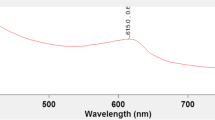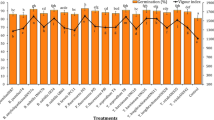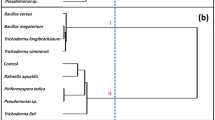Abstract
Tomato is an important nutritional vegetable crop and its nutrient contents are affected by both biotic and abiotic stresses. The main objective of this study was to determine the effect of seed biopriming with Trichoderma pseudokoningii BHUR2 and vermiwash treatment on nutrient content of tomato and defense response against Sclerotium rolfsii under heat stress condition. The combined application of T. pseudokoningii BHUR2 and vermiwash increased fresh weight of root (4.8-fold) and shoot (5.8-fold), dry weight of root (6.9-fold) and shoot (6.4-fold) and number of fruits per plant (4.2-fold) as compared to control under S. rolfsii inoculated condition. Plants treated with T. pseudokoningii BHUR2 and vermiwash exhibited higher defense response against S. rolfsii, mediated by higher activity of superoxide dismutase (3.57-fold), peroxidase (2.05-fold) and phenylalanine ammonia lyase (2.98-fold) enzymes and accumulation of total phenol content (5.35-fold) as compared to control plants. In addition, combined treatment was found to have a positive impact on nutritional status (N, P, K and Ca and lycopene, total soluble sugar and total protein) in tomato fruit. These results suggest potential of T. pseudokoningii BHUR2 and vermiwash in enhancing tomato immunity against S. rolfsii under heat stress condition, which was due to (1) induction in the antioxidant activity and phenylpropanoid pathway, which minimize oxidative damage and reduce pathogen infection and (2) significant improvement in nutrient content leads to better plant growth. The formulation of Trichoderma BHUR2 can be used for field application to mitigate heat stress in plants.










Similar content being viewed by others
References
Abo-Elyousr KA, Hashem M, Ali EH (2009) Integrated control of cotton root rot disease by mixing fungal biocontrol agents and resistance inducers. Crop Prot 28(4):295–301
Agrawal T, Kotasthane AS (2012) Chitinolytic assay of indigenous Trichoderma isolates collected from different geographical locations of Chhattisgarh in Central India. SpringerPlus 1(1):73–79
Begoude BAD, Lahlali R, Friel D, Tondje PR, Jijakli MH (2007) Response surface methodology study of the combined effects of temperature, pH, and aw on the growth rate of Trichoderma asperellum. J Appl Microbiol 103(4):845–854
Bi L, Zhang B, Liu G, Li Z, Liu Y, Ye C, Yu X, Lai T, Zhang J, Yin J, Liang Y (2009) Long-term effects of organic amendments on the rice yields for double rice cropping systems in subtropical China. Agric Ecosyst Enviro 129(4):534–541
Bisen K, Keswani C, Patel JS, Sarma BK, Singh HB (2016) Trichoderma spp.: efficient inducers of systemic resistance in plants. In: Microbial-mediated induced systemic resistance in plants, Springer, Singapore, p 185–195
Bric JM, Bostock RM, Silverstone SE (1991) Rapid in situ assay for indoleacetic acid production by bacteria immobilized on a nitrocellulose membrane. Appl Environ Microbiol 57(2):535–538
Brueske CH (1980) Phenylalanine ammonia lyase activity in tomato roots infected and resistant to the root-knot nematode Meloidogyne incognita. Physiol Plant Pathol 16(3):409–414
Callan NW, Mathre D, Miller JB (1990) Bio-priming seed treatment for biological control of Pythium ultimum preemergence damping-off in sh-2 sweet corn. Plant Dis 74:368–372
Contreras-Cornejo HA, Macías-Rodríguez L, Alfaro-Cuevas R, López-Bucio J (2014) Trichoderma spp. improve growth of Arabidopsis seedlings under salt stress through enhanced root development, osmolite production, and Na+ elimination through root exudates. Mol Plant Microbe Interact 27(6):503–514
Crisan EV (1973) Current concepts of thermophilism and the thermophilic fungi. Mycologia 65:1171–l198
Cushman JC (2001) Osmoregulation in plants: implications for agriculture. Am zool 41(4):758–769
Das T, Majumdar MHD, Devi RT, Rajesh T (2016) Climate change impacts on plant diseases. SAARC J Agri 14(2):200–209
De Curtis F, Lima G, Vitullo D, De Cicco V (2010) Biocontrol of Rhizoctonia solani and Sclerotium rolfsii on tomato by delivering antagonistic bacteria through a drip irrigation system. Crop Protect 29(7):663–670
Elad Y, Chet I, Henis Y (1981) A selective medium for improving quantitative isolation of Trichoderma spp. from soil. Phytoparasitica 9(1):59–67
Fish WW, Perkins-Veazie P, Collins JK (2002) A quantitative assay for lycopene that utilizes reduced volumes of organic solvents. J Food Compos Anal 15(3):309–317
Gregory EM, Goscin SA, Fridovich I (1974) Superoxide dismutase and oxygen toxicity in a eukaryote. J Bacteriol 117(2):456–460
Hammerschmidt R, Nuckles EM, Kuć J (1982) Association of enhanced peroxidase activity with induced systemic resistance of cucumber to Colletotrichum lagenarium. Physiol Plant Pathol 20(1):73–82
Harman GE, Howell CR, Viterbo A, Chet I, Lorito M (2004) Trichoderma species—opportunistic, avirulent plant symbionts. Nat Rev Microbiol 2(1):43
Hatti SS, Londonkar RL, Patil SB, Gangawane AK, Patil CS (2010) Effect of Eisenia fetidavermiwash on the growth of plants. J Crop Sci 1(1):6–10
Hedge JE, Hofreiter BT (1962) Estimation of carbohydrate. Methods in carbohydrate chemistry. Academic Press, New York, pp 17–22
Hankin L, Anagnostakis SL (1975) The use of solid media for detection of enzyme production by fungi. Mycologia 67(3):597–607
Howell CR (2003) Mechanisms employed by Trichoderma species in the biological control of plant diseases: the history and evolution of current concepts. Plant Dis 87(1):4–10
IPCC (2007) Climate Change 2007. The physical science basis. Summary for policymakers. Contribution of working group I to the fourth assessment report of the intergovernmental panel on climate change. IPCC, Geneva
Jain A, Singh A, Singh S, Singh HB (2013a) Microbial consortium-induced changes in oxidative stress markers in pea plants inoculated with Sclerotinia sclerotiorum. J Plant Growth Regul 32(2):388–398
Jain A, Singh S, Sarma BK, Singh HB (2011) Microbial consortium–mediated reprogramming of defence network in pea to enhance tolerance against Sclerotinia sclerotiorum. J Appl Microbiol 112:537–550
Jain S, Vaishnav A, Kasotia A, Kumari S, Gaur RK, Choudhary DK (2013b) Bacteria-induced systemic resistance and growth promotion in Glycine max L. Merrill upon challenge inoculation with Fusarium oxysporum. Proc Natl Acad Sci, India. Sect B Biol Sci 83:561–567
Jain S, Vaishnav A, Kasotia A, Kumari S, Gaur RK, Choudhary DK (2014a) Rhizobacterium- mediated growth promotion and expression of stress enzymes in Glycine max L. Merrill against Fusarium wilt upon challenge inoculation. World J Microbiol Biotechnol 30:399–406
Jain S, Vaishnav A, Kumari S, Varma A, Tuteja N, Choudhary DK (2016) Chitinolytic Bacillus-mediated induction of jasmonic acid and defense-related proteins in soybean (Glycine max L. Merrill) plant against Rhizoctonia solani and Fusarium oxysporum. J Plant Growth Regul 36:200–214
Jain S, Vaishnav A, Kasotia A, Kumari S, Choudhary DK (2014b) Plant growth-promoting bacteria elicited induced systemic resistance and tolerance in plants. In: Ahmad P et al. (eds.) Emerging technologies and management of crop stress tolerance, Vol 2, Elsevier. https://doi.org/10.1016/B978-0-12-800875-1.00005_3
Keswani C, Bisen K, Singh SP, Sarma BK, Singh HB (2016) A proteomic approach to understand the tripartite interactions between plant-Trichoderma-pathogen: Investigating the potential for efficient biological control. Plant, Soil and Microbes. Springer, Cham, pp 79–93
Kimura M (1980) A simple method for estimating evolutionary rates of base substitutions through comparative studies of nucleotide sequences. J Mol Evol 16(2):111–120
Klein BP, Perry AK (1982) Ascorbic acid and vitamin A activity in selected vegetables from different geographical areas of the United States. J Food Sci 47(3):941–945
Kredics L, Antal Z, Manczinger L, Szekeres A, Kevei F, Nagy E (2003) Influence of environmental parameters on Trichoderma strains with biocontrol potential. Food Technol Biotech 41(1):37–42
Kumar A, Verma JP (2018) Does plant—microbe interaction confer stress tolerance in plants: a review? Microbiol Res 207:41–52
Li J, Feng MG (2009) Intraspecific tolerance of Metarhizium anisopliae conidia to the upper thermal limits of summer with a description of a quantitative assay system. Mycol Res 113:93–99
Lowry OH, Rosebrough NJ, Farr AL, Randall RJ (1951) Protein measurement with the Folin phenol reagent. J Biol Chem 193:265–275
Makkar C, Singh J, Parkash C (2017) Vermicompost and vermiwash as supplement to improve seedling, plant growth and yield in Linum usitassimum L. for organic agriculture. Int J Recycl Org Waste Agric 6(3):203–218
Martínez-Medina A, Alguacil MDM, Pascual JA, Van Wees SC (2014) Phytohormone profiles induced by Trichoderma isolates correspond with their biocontrol and plant growth-promoting activity on melon plants. J Chem Ecol 40(7):804–815
Mishra S, Nautiyal CS (2012) Reducing the allelopathic effect of Parthenium hysterophorus L on wheat (Triticum aestivum L) by Pseudomonas putida. Plant Growth Regul 66(2):155–165
Mukherjee PK, Raghu K (1997) Effect of temperature on antagonistic and biocontrol potential of shape Trichoderma sp. on Sclerotium rolfsii. Mycopathologia 139(3):151–155
Nahar K, Hasanuzzaman M, Ahamed KU, Hakeem KR, Ozturk M, Fujita M (2015). Plant responses and tolerance to high temperature stress: role of exogenous phytoprotectants. In: Hakeem K (eds) Crop production and global environmental issues. Springer, Cham
Nahar K, Hasanuzzaman M, Alam MM, Fujita M (2015) Exogenous glutathione confers high temperature stress tolerance in mung bean (Vigna radiata L.) by modulating antioxidant defense and methylglyoxal detoxification system. Environ Exper Bot 112:44–54
Ohkawa H, Ohishi N, Yagi K (1979) Assay for lipid peroxides in animal tissues by thiobarbituric acid reaction. Anal Biochem 95(2):351–358
Pathma J, Sakthivel N (2012) Microbial diversity of vermicompost bacteria that exhibit useful agricultural traits and waste management potential. Springer Plus 1(1):26
Payne SM (1993) Iron acquisition in microbial pathogenesis. Trends Microbiol 1:66–69
Poosapati S, Ravulapalli PD, Tippirishetty N, Vishwanathaswamy DK, Chunduri S (2014) Selection of high temperature and salinity tolerant Trichoderma isolates with antagonistic activity against Sclerotium rolfsii. Springer Plus 3(1):641
Punja ZK (1985) Sclerotium (Athelia) rolfsii, a pathogen of many plant species. In: Advances in plant pathology. Academic Press, p 523–534
Rajput RS, Singh P, Singh J, Ray S, Vaishnav A, Singh HB (2019b) Seed biopriming through beneficial rhizobacteria for mitigating soilborne and seed-borne diseases. In: Sayyed RZ (ed.), Plant growth promoting rhizobacteria for sustainable stress management, microorganisms for sustainability. Springer Nature, Singapore, p 13. https://doi.org/10.1007/978-981-13-6986-5_7.
Rajput RS, Ram RM, Vaishnav A, Singh HB (2019). Microbe-based novel biostimulants for sustainable crop production. In: microbial diversity in ecosystem sustainability and biotechnological applications, Springer, Singapore, pp 109–144
Rifai MA (1969) A revision of the genus Trichoderma. Mycological papers 116:1–56
Rouphael Y, Cardarelli M, Bonini P, Colla G (2017) Synergistic action of a microbial-based biostimulant and a plant derived-protein hydrolysate enhances lettuce tolerance to alkalinity and salinity. Front Plant Sci 8:131
Sarma BK, Yadav SK, Patel JS, Singh HB (2014) Molecular mechanisms of interactions of Trichoderma with other fungal species. Open Mycol J 8:140–147
Shahid M, Srivastava M, Kumar V, Singh A, Sharma A, Pandey S, Rastogi S, Pathak N, Srivastava AK (2014) Phylogenetic diversity analysis of Trichoderma species based on internal transcribed spacer (ITS) marker. Afr J Biotechnol 13
Shokes FM, Róźalski K, Gorbet DW, Brenneman TB, Berger DA (1996) Techniques for inoculation of peanut with Sclerotium rolfsii in the greenhouse and field. Peanut Sci 23(2):124–128
Shoresh M, Harman GE (2008) The molecular basis of shoot responses of maize seedlings to Trichoderma harzianum T22 inoculation of the root: a proteomic approach. Plant physiol 147(4):2147–2163
Singh A, Jain A, Sarma BK, Upadhyay RS, Singh HB (2014) Rhizosphere competent microbial consortium mediates rapid changes in phenolic profiles in chickpea during Sclerotium rolfsii infection. Microbiol Res 169:353–360
Singh A, Shahid M, Srivastava M, Pandey S, Sharma A, Kumar V (2014) Optimal physical parameters for growth of Trichoderma species at varying pH, temperature and agitation. Virol Mycol 3(1):127–134
Singh SP, Singh HB, Singh DK (2013) Trichoderma harzianum and Pseudomonas sp. mediated management of Sclerotium rolfsii rot in tomato (Lycopersicon esculentum Mill.). Life Sci 8(3):801–804
Singh P, Singh J, Ray S, Rajput RS, Vaishnav A, Singh RK, Singh HB (2020) Seed biopriming with antagonistic microbes and ascorbic acid induce resistance in tomato against Fusarium wilt. Microbiol Res 237:126482
Suriyagamon S, Phonkerd N, Bunyatratchata W, Riddech N, Mongkolthanaruk W (2018) Compost Seed of Trichoderma harzianum UD12-102 in Controlling Collar and Stem Rot of Tomato Caused by Sclerotium rolfsii. Environ Nat Resource J 16(2):20–2
Tamura K, Nei M (1993) Estimation of the number of nucleotide substitutions in the control region of mitochondrial DNA in humans and chimpanzees. Mol Biol Evol 10(3):512–526
Vaishnav A, Jain S, Kasotia A, Kumari S, Gaur RK, Choudhary DK (2014) Molecular mechanism of benign microbe-elicited alleviation of biotic and abiotic stresses for plants. In: Gaur RK et al. (eds.) Approaches to plant stress and their management, Springer, India, https://doi.org/10.1007/978-81-322-1620-9_16
Vaishnav A, Shukla A, Sharma A, Kumar R, Choudhary DK (2019) Endophytic bacteria in plant salt stress tolerance: current and future prospects. J Plant Growth Regul 38:650–668
Vaishnav A, Singh J, Singh P, Rajput RS, Singh HB, Sarma BK (2020) Sphingobacterium sp. BHU-AV3 induces salt tolerance in tomato by enhancing antioxidant activities and energy metabolism. Front Microbiol 11:443
Verma S, Babu A, Patel A, Singh SK, Pradhan SS, Verma SK, Singh JP, Singh RK (2018) Significance of vermiwash on crop production: A review. J Pharmacogn Phytochem 7(2):297–301
Vijayaraghavan P, Samuel GPV (2013) A simple method for the detection of protease activity on agar plates using bromocresolgreen dye. J Biochem Tech 4(3):628–630
Virginia CC (2006) Soil inoculation with Trichoderma pseudokoningii Rifai enhances yield of rice. Philipp J Sci 135(1):31–37
Wahid A, Gelani S, Ashraf M, Foolad MR (2007) Heat tolerance in plants: an overview. Environ Exper Bot 61(3):199–223
Woo SL, Ruocco M, Vinale F, Nigro M, Marra R, Lombardi N, Pascale A, Lanzuise S, Manganiello G, Lorito M (2014) Trichoderma-based products and their widespread use in agriculture. Open Mycol J 8
Zheng Z, Shetty K (2000) Solid-state bioconversion of phenolics from cranberry pomace and role of Lentinus edodes β-glucosidase. J Agric Food Chem 48(3):895–900
Acknowledgements
R. S. Rajput and P. Singh are grateful to UGC- RET scholarship, A Vaishnav is grateful to SERB-NPDF (PDF/2017/000689) and J. Singh is grateful to CSIR-JRF for providing financial assistance.
Author information
Authors and Affiliations
Contributions
RSR, JS and PS performed the experiments. RSR and AV drafted the manuscript. HBS coordinated the work and gave valuable comments.
Corresponding authors
Ethics declarations
Conflict of interest
The authors declare that they have no conflict of interest.
Ethical Approval
This article does not contain any studies with human participants or animals performed by any of the authors.
Additional information
Publisher's Note
Springer Nature remains neutral with regard to jurisdictional claims in published maps and institutional affiliations.
Rights and permissions
About this article
Cite this article
Rajput, R.S., Singh, J., Singh, P. et al. Influence of Seed Biopriming and Vermiwash Treatment on Tomato Plant's Immunity and Nutritional Quality upon Sclerotium rolfsii Challenge Inoculation. J Plant Growth Regul 40, 1493–1509 (2021). https://doi.org/10.1007/s00344-020-10205-1
Received:
Accepted:
Published:
Issue Date:
DOI: https://doi.org/10.1007/s00344-020-10205-1




